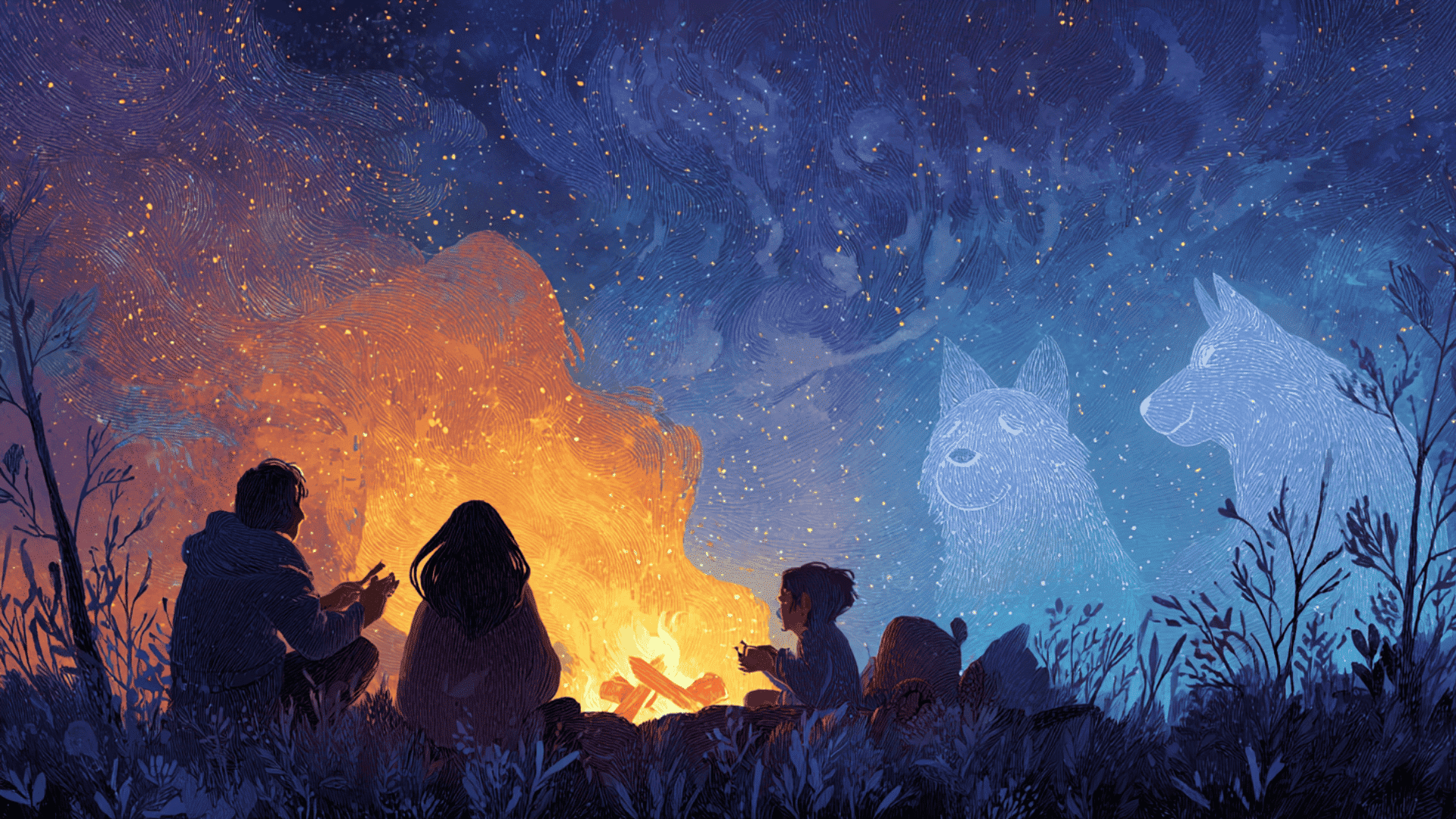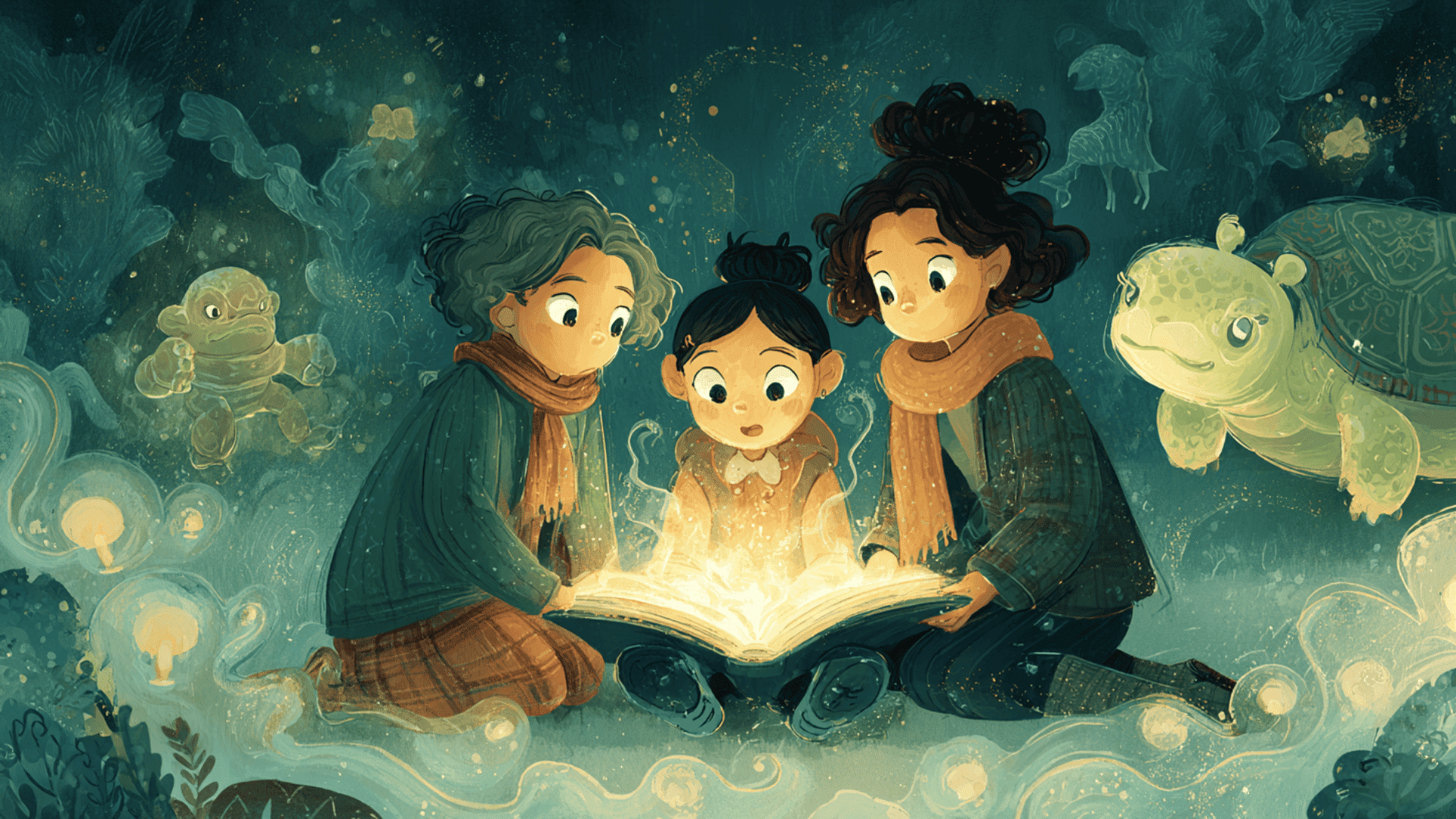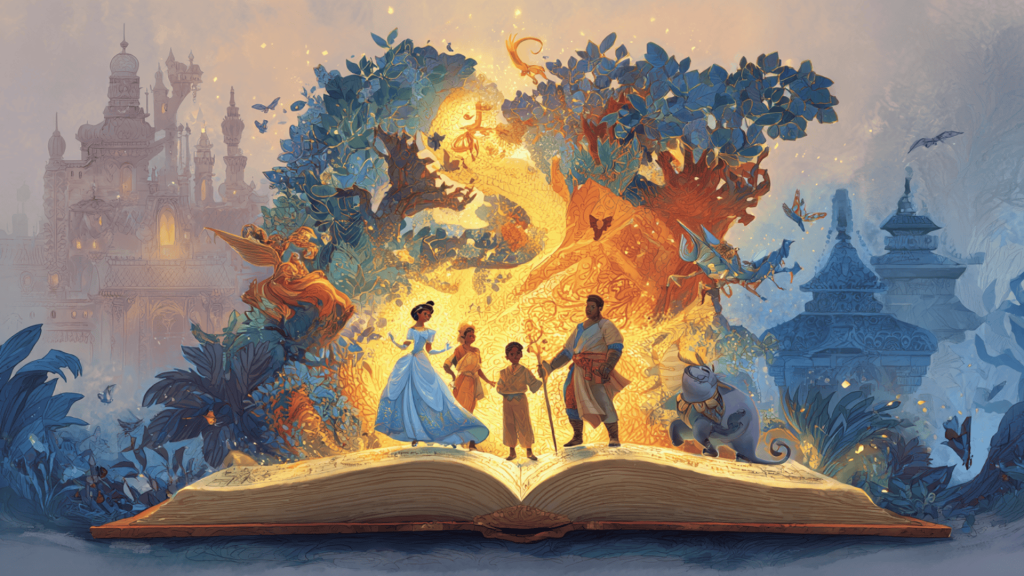I’ve always believed stories tell us more than facts ever could. They carry lessons, emotions, and pieces of culture that stick with you long after the words are gone.
Folktales are some of the best examples of this. They’ve been passed down for generations, shaped by the people who told them, and they still feel just as alive today.
When you look at folktales, you’ll see how they connect everyday life with bigger ideas like courage, kindness, and cleverness. They often reveal what mattered most to different communities.
Let’s start by breaking it down and asking a simple question.
What is a Folktale?
A folktale is a traditional story passed down through generations. These stories were first shared by word of mouth before being written down.
Folktales usually teach lessons, explain natural events, or show cultural values. They often use simple characters, magical elements, or talking animals to share wisdom.
It helps to know how folktales differ from other types of stories:
- Fairy tale: Often includes magic, royalty, or fantasy settings (like Cinderella).
- Myth: Explains natural events, gods, or creation (like Greek myths).
- Fable: A short story with animals as characters and a clear moral (like Aesop’s fables).
- Tall tale: An exaggerated story about larger-than-life characters (like Paul Bunyan).
Folktales connect people to their culture and are still shared today to teach and entertain.
Famous Folktale Examples Across Cultures

Folktales are told in every culture, each with its own lesson. Here are some of the most memorable stories from around the world:
1. Anansi the Spider (Africa)
A clever spider tricks animals and humans, using his wits to solve problems. His stories teach lessons about greed, pride, and the power of intelligence over strength.
2. The Lion’s Whisker (Ethiopia)
A stepmother learns patience by plucking a lion’s whisker to heal her stepson. This tale shows how love, persistence, and understanding can mend even the hardest relationships.
3. Why the Sky is Far Away (Nigeria)
Long ago, people could eat pieces of the sky, but wastefulness angered it. The sky moved far away, teaching the importance of gratitude and avoiding waste.
4. The Clever Jackal (South Africa)
A jackal outsmarts stronger animals like lions and hyenas. These stories show how quick thinking and resourcefulness can often win over brute strength or physical power.
5. The Tortoise and the Birds (West Africa)
Tortoise tricks birds into helping him attend a feast in the sky. His greed causes him to fall, teaching humility and the consequences of selfish actions.
6. The Magic Drum (Nigeria)
A drum that produces endless food and drink is stolen by a greedy man. His dishonesty ruins him, while honesty and generosity bring reward and community respect.
7. The Girl Who Lived with the Lions (Sudan)
A young girl escapes a cruel stepmother and finds safety among lions. The animals protect her, teaching lessons about resilience, loyalty, and the kindness found in nature.
8. How the Zebra Got Its Stripes (Africa)
A greedy donkey is punished and receives black stripes across its body. This pourquoi tale explains natural features while warning about selfishness and ignoring wise advice.
9. The Crocodile and the Monkey (Africa)
A crocodile tries to trick a monkey into giving up his heart. The monkey’s clever escape shows the value of wit and awareness when faced with betrayal.
10. The Two Friends and the Lion (Africa)
Two traveling friends meet a lion. One climbs a tree, while the other plays dead. The story teaches the importance of true friendship and loyalty in danger.
11. The Magic Paintbrush (China)
A poor boy receives a brush that makes drawings come alive. He uses it to help the poor, showing how kindness and creativity can overcome greed and injustice.
12. Journey to the West – Monkey King (China)
The Monkey King rebels against heaven, then joins a monk on a sacred journey. His mix of mischief and bravery teaches lessons about loyalty, perseverance, and transformation.
13. Momotaro, the Peach Boy (Japan)
A boy born from a peach grows into a brave warrior. With animal friends, he defeats ogres, teaching teamwork, courage, and the importance of helping one’s community.
14. The Grateful Crane (Japan)
A man rescues a crane that later returns as a woman. She weaves magical cloth to repay him, teaching gratitude, sacrifice, and the dangers of human greed.
15. The White Snake (China)
A serpent spirit falls in love with a man, facing challenges from a priest. The tale explores love, sacrifice, and the struggles between duty, devotion, and tradition.
16. The Rabbit in the Moon (East Asia)
A rabbit sacrifices itself to feed a hungry traveler, who is actually a god. Moved, the god places the rabbit on the moon as a symbol of kindness.
17. The Bamboo Cutter and the Moon Child (Japan)
An old man finds a glowing bamboo stalk holding a tiny girl. She grows into Princess Kaguya, who later returns to the moon, symbolizing beauty and impermanence.
18. The Cowherd and the Weaver Girl (China)
A mortal cowherd and a heavenly maiden fall in love. They are separated by the gods, meeting only once a year, symbolizing devotion and eternal love against obstacles.
19. The Grateful Tiger (Korea)
A tiger spares a poor man’s life and later brings him fortune. This story shows that kindness, even toward dangerous creatures, can bring unexpected rewards and lasting respect.
20. The Blind Men and the Elephant (South Asia)
Blind men each touch part of an elephant and argue about what it is. The story shows how a limited perspective creates misunderstanding and why humility matters.
21. Paul Bunyan (USA)
A giant lumberjack, with his blue ox Babe, shapes rivers, lakes, and forests. His tall tales highlight human strength, humor, and the myth of conquering wild landscapes.
22. Davy Crockett (USA)
A frontiersman and hunter known for bravery and wit, Crockett’s stories blend truth and exaggeration. They celebrate courage, independence, and humor in America’s early frontier days.
23. Pecos Bill (USA)
A cowboy raised by coyotes becomes a legendary hero. He lassos tornadoes, rides mountain lions, and reshapes the West, reflecting the exaggeration and wild spirit of tall tales.
24. Johnny Appleseed (USA)
A wandering man plants apple trees across the frontier. His story blends history and folklore, teaching kindness, generosity, and the importance of living in harmony with nature.
25. John Henry (USA)
A steel driver competes against a machine to prove human strength. He wins but dies in the process, symbolizing sacrifice, dignity in labor, and resistance against change.
26. Br’er Rabbit (Southern USA)
A clever rabbit tricks stronger animals like Br’er Fox and Br’er Bear. These stories teach how wit and clever words can overcome strength, oppression, and unfair power.
27. Rip Van Winkle (USA)
A lazy man drinks a magic potion, falls asleep for 20 years, and wakes to a new world. It reflects themes of change, time, and lost opportunity.
28. The Headless Horseman (USA)
A ghostly rider haunts a small town, chasing travelers at night. This eerie folktale warns about fear, superstition, and the power of community legends to shape behavior.
29. The Invisible Mountain (Wyoming, USA)
An enchanted crystal mountain hidden by a witch’s curse. Travelers seeking treasure never return, warning about greed, curiosity, and the dangers of ignoring old local wisdom.
30. The Jersey Devil (USA)
A winged creature haunts New Jersey’s Pine Barrens. The tale blends superstition and fear, showing how folklore can explain strange events and give communities a shared identity.
31. Cinderella (Europe)
A mistreated girl overcomes cruelty from her stepfamily with kindness and patience. Magical help leads her to happiness, showing the power of hope, goodness, and perseverance against hardship.
32. Little Red Riding Hood (Europe)
A young girl is tricked by a cunning wolf while visiting her grandmother. The tale warns children about trust, awareness, and the dangers of talking to strangers.
33. Hansel and Gretel (Germany)
Abandoned siblings discover a witch’s candy house. They outsmart her and escape, showing themes of courage, cleverness, and survival despite fear, hunger, and betrayal by adults.
34. Jack and the Beanstalk (England)
Jack trades beans for a magical stalk reaching the sky. He defeats a giant, teaching lessons about bravery, risk-taking, and using cleverness to overcome impossible odds.
35. Snow White and the Seven Dwarfs (Germany)
A princess escapes her jealous stepmother and finds safety with dwarves. The story reflects beauty, jealousy, kindness, and the belief that goodness triumphs over cruelty and envy.
36. The Frog Prince (Germany)
A spoiled princess befriends a frog who transforms into a prince. The story highlights keeping promises, the value of kindness, and the rewards of true acceptance.
37. The Bremen Town Musicians (Germany)
Old animals set out to find new lives, but end up scaring robbers from a cottage. This tale celebrates friendship, second chances, and working together against challenges.
38. The Pied Piper of Hamelin (Germany)
A piper rids a town of rats but is cheated of payment. In revenge, he leads away children, warning about broken promises and the dangers of dishonesty.
39. Goldilocks and the Three Bears (England)
A curious girl enters a bear’s home, eats their food, and breaks their belongings. The tale warns against selfishness, disrespect, and trespassing on what belongs to others.
40. The Goose Girl (Germany)
A princess betrayed by her maid survives hardship and reclaims her place. The story teaches loyalty, justice, and the idea that truth will always come to light.
41. The Boy Who Cried Wolf (Aesop’s Fables)
A shepherd boy repeatedly lies about wolves attacking his flock. When danger is real, no one believes him, teaching the lasting consequences of dishonesty and broken trust.
42. The Tortoise and the Hare (Aesop’s Fables)
A speedy hare mocks a slow tortoise. In a race, the tortoise wins through steady effort. The story shows the power of patience, persistence, and humility.
43. The Lion and the Mouse (Aesop’s Fables)
A lion spares a mouse, who later rescues him from hunters. This fable proves that small acts of kindness can return in surprising and life-saving ways.
44. The Fox and the Grapes (Aesop’s Fables)
A hungry fox cannot reach the grapes and claims they are sour. The story explains how people devalue what they cannot have, highlighting pride, frustration, and self-deception.
45. The Ant and the Grasshopper (Aesop’s Fables)
An ant works hard while a grasshopper plays. Winter comes, and the grasshopper suffers. The fable emphasizes preparation, responsibility, and the rewards of planning ahead.
46. The Crow and the Pitcher (Aesop’s Fables)
A thirsty crow drops stones into a pitcher to raise the water. It shows how clever problem-solving and persistence can overcome challenges that seem impossible.
47. The Dog and the Shadow (Aesop’s Fables)
A dog carrying meat sees its reflection and tries to grab it, losing both. This tale warns against greed and losing what you already have.
48. The Wolf in Sheep’s Clothing (Aesop’s Fables)
A wolf disguises itself as a sheep to prey on a flock. The fable teaches caution, showing appearances can deceive and danger often hides in plain sight.
49. The Bundle of Sticks (Aesop’s Fables)
A father shows his sons that sticks break easily when apart but not together. It highlights unity, cooperation, and the strength found in family and community bonds.
50. The Farmer and the Stork (Aesop’s Fables)
A stork caught in a net pleads innocence but is punished with the cranes. The fable warns that we are judged by the company we keep.
51. Coyote the Trickster (Native American)
Coyote is clever yet reckless, often creating chaos. His stories explain natural events while teaching humility, responsibility, and the consequences of mischief mixed with wisdom.
52. Raven the Trickster (Native American)
Raven steals the sun, moon, and stars to give light to the world. His actions show both selfishness and generosity, reflecting a balance between greed and community good.
53. The Great Flood (Native American)
A great flood covers the earth, but a small animal brings soil to create land again. This tale emphasizes sacrifice, cooperation, and renewal after disaster.
54. Maui Snaring the Sun (Hawaii)
The demigod Maui traps the sun to slow its journey, giving people longer days. The story shows ingenuity, courage, and the importance of balance in nature.
55. Maori Creation Stories (New Zealand)
Tales describe how the sky father and earth mother were separated, creating light and life. They show respect for nature, ancestry, and the origins of existence.
56. Ali Baba and the Forty Thieves (Middle East)
A poor man discovers thieves’ treasure hidden in a cave. With bravery and cleverness, he outsmarts them, highlighting honesty, courage, and how greed leads to downfall.
57. Aladdin and the Magic Lamp (Middle East)
A poor boy finds a lamp with a genie who grants wishes. The story blends adventure, temptation, and the struggle between using power wisely or selfishly.
Folktales for Kids, Students, and Adults

Folktales can be shared with people of all ages, but different versions work better depending on the audience.
- For kids: Short and simple stories with animals, magic, or repeating patterns work best.
- For students: Slightly longer folktales with clear morals and cultural background are useful.
- For adults: Longer and more complex tales offer deeper meaning.
Teachers and parents often use folktales to teach story structure. Activities may include retelling a folktale, identifying the lesson, or comparing stories from different cultures. Printable collections and summaries can make this even easier in classrooms or at home.
Why Folktales Still Matter Today
Folktales continue to influence modern life, even if we don’t always notice it.
Many popular books, plays, and films borrow characters, plots, or themes from traditional tales. Stories like Cinderella and Snow White still inspire new versions across the world.
These tales also teach values like honesty, kindness, and bravery in simple ways that children and adults can understand. They encourage respect for cultural traditions and remind us of the power of storytelling.
By keeping folktales alive, we protect not just stories, but also the history, wisdom, and imagination of people everywhere.
Wrapping Up
When I think about folktales, I see more than just stories. They’re reminders of how people once explained the world, taught lessons, and shared wisdom in ways that still make sense today.
You’ll notice that many folktale examples focus on values like honesty, kindness, or bravery, and those are things we still look for in everyday life.
Reading them makes me feel connected not only to the past but also to people in different cultures. You might feel the same when you read them yourself.
If you’d like to keep going, check out more of my blogs for fresh ideas and stories worth reading.











